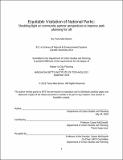| dc.contributor.advisor | Ceasar McDowell. | en_US |
| dc.contributor.author | Buono, Tessa Mae. | en_US |
| dc.contributor.other | Massachusetts Institute of Technology. Department of Urban Studies and Planning. | en_US |
| dc.date.accessioned | 2020-02-28T20:52:11Z | |
| dc.date.available | 2020-02-28T20:52:11Z | |
| dc.date.copyright | 2019 | en_US |
| dc.date.issued | 2019 | en_US |
| dc.identifier.uri | https://hdl.handle.net/1721.1/123946 | |
| dc.description | This electronic version was submitted by the student author. The certified thesis is available in the Institute Archives and Special Collections. | en_US |
| dc.description | Thesis: M.C.P., Massachusetts Institute of Technology, Department of Urban Studies and Planning, 2019 | en_US |
| dc.description | Cataloged from student-submitted PDF version of thesis. | en_US |
| dc.description | Includes bibliographical references (pages 116-118). | en_US |
| dc.description.abstract | This research provides a deep dive into the lives of community organization leaders and National Park Service staff who work to promote diversity outdoors through hiking programs, the arts, advocacy, and more. The Santa Monica Mountains National Recreation Area (outside of Los Angeles California) is used as a case study to research the successes and challenges for more equitably distributing park's positive impacts on health and well-being to its adjacent communities. This research inquires questions around sense of belonging, feeling welcome, and other factors that might impact one's experience outdoors. Qualitative interviews with community organizations and NPS staff shed light on successes and challenges to reaching their goals of bringing more diverse groups to the Santa Monica Mountains National Recreation Area (SAMO). This research culminates with park planning recommendations to make national park units more equitably visited and enjoyed by all. Before diving into the case study at the Santa Monica Mountains National Recreation Area, an overview of current literature explains why promoting diversity outdoors is important and why it can sometimes be a challenging task. | en_US |
| dc.description.statementofresponsibility | by Tessa Mae Buono. | en_US |
| dc.format.extent | 118 pages | en_US |
| dc.language.iso | eng | en_US |
| dc.publisher | Massachusetts Institute of Technology | en_US |
| dc.rights | MIT theses are protected by copyright. They may be viewed, downloaded, or printed from this source but further reproduction or distribution in any format is prohibited without written permission. | en_US |
| dc.rights.uri | http://dspace.mit.edu/handle/1721.1/7582 | en_US |
| dc.subject | Urban Studies and Planning. | en_US |
| dc.title | Equitable visitation of national parks : shedding light on community partner perspectives to improve park planning for all | en_US |
| dc.title.alternative | Shedding light on community partner perspectives to improve park planning for all | en_US |
| dc.type | Thesis | en_US |
| dc.description.degree | M.C.P. | en_US |
| dc.contributor.department | Massachusetts Institute of Technology. Department of Urban Studies and Planning | en_US |
| dc.identifier.oclc | 1140386094 | en_US |
| dc.description.collection | M.C.P. Massachusetts Institute of Technology, Department of Urban Studies and Planning | en_US |
| dspace.imported | 2020-02-28T20:52:10Z | en_US |
| mit.thesis.degree | Master | en_US |
| mit.thesis.department | UrbStud | en_US |
